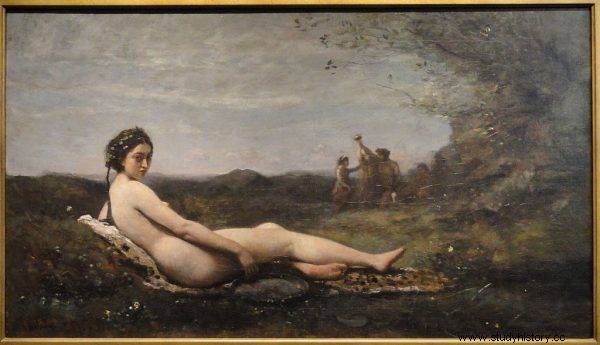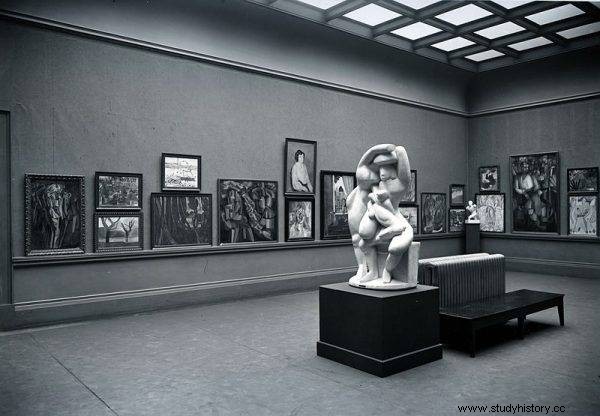Counterfeits in the art world keep historians, researchers, buyers and collectors awake at night. And for good reason! It is estimated that over a dozen percent of the works that we can admire in museums are fakes. How is it possible that even in the best cultural institutions, fraud is not always caught? Well, apparently they are perfect forgery ...
Apparently, Michelangelo, as Frank Wynne writes in his book I was Vermeer , "borrowed works of art to make copies, but returned the copies and kept the originals for himself" . The history of counterfeits in art, however, began much earlier - Roman copies of Greek sculptures can be considered a far-reaching imitation.
Orson Welles, an American filmmaker, stated that "forgery is as old as the Garden of Eden." He was right - without a doubt, the first forgeries began to appear along with the development of art, a long, long time ago. It doesn't take long to find out that hundreds of thousands (and maybe more) of counterfeits may have been produced over the centuries.
Some of them still hang comfortably on the walls of famous museums. Such brilliant counterfeits that are hard to detect needed equally genius creators. Who are the most famous forgers in art history? Here are three of the most famous - and how talented - cheaters.
Han van Meegeren - underestimated painter, outstanding forger
Han van Meegeren was a Dutch painter. He was born in 1889, so definitely… too late. Why is it too late? Because his works beautifully matched the aesthetics of the paintings of the old masters from previous eras, thus not matching the developing new trends and tastes at the beginning of the 20th century.
Van Meegeren was praised for his skill and craftsmanship, but accused of lack of originality . Critics have argued that his paintings are copies of old works . The ambitious painter decided to take revenge for unflattering opinions in an "artistic" way - creating fakes. He decided to counterfeit Johannes Vermeer. He chose this artist for a reason - Vermeer was a representative of the art Han valued the most. He wanted to prove that he can not only copy well, but also create images as good as the old masters. And he proved it.

Van Meegeren was praised for his skill and craftsmanship, but accused of lack of originality. Critics claimed his paintings were copies of old works.
Before he painted his first counterfeit, however, he prepared for several years - he conducted research on Vermeer's work, experimented with paints, looked for old canvases and brushes from the 17th century. He made such efforts that did in fact create a 17th-century painting. And then more. The work known as Supper at Emmaus is considered the most famous fake. or Students in Emaus from 1937, which van Meegeren sold for over 500,000 thousand guilders. Needless to say, he didn't get that much money for the paintings signed with his name.
Van Meegeren's forgeries were not discovered until the mid-1940s. During the trial, the painter admitted that he had forged fourteen works for several years, nine of which he had sold. He claimed that he had received a total of 7,167,000 guilders for the counterfeits sold. If he hadn't been pretending to be someone else, he wouldn't have earned that much.
Eric Hebborn who forgot that a counterfeiter should go into hiding
Eric Hebborn, born in 1934, did not have an easy childhood. He was abused by his parents, and the house was in poverty. Already as a child he showed a talent for painting, but he could not count on access to decent tools, so he drew with burned matches.
When his collection of matches was discovered at the school, he was severely punished. In an act of revenge, Eric set fire to the school, for which he ended up in a reformatory. However, he managed to finish his education and even got to study at the Royal Academy of Arts in London. He was talented - he won prizes in competitions for students, he received a scholarship, thanks to which he went to Rome. Nevertheless, after graduation, he did not gain recognition in the eyes of critics.
So he decided to create fakes, although, unlike other forgeries, he did not imitate existing paintings, but painted new ones in the style of a specific artist. He began by drawing sketches of little-known painters, which he easily sold. Later he had no hesitation to paint on behalf of Rubens, Corot or van Dyck. He did it so well that all the works that came out of his hand were considered lost works of the old masters. Of course, he made a fortune with the fakes.

Eric Hebborn did not hesitate to paint on behalf of Rubens, Corot or Van Dyck.
Apparently, he lacked fame and recognition to his fortune, since in 1984 admitted his forgeries. Not only that, in the 90s he published two books - the autobiography Drawn to trouble and a "handbook" for image counterfeiters The Art Forger's Handbook in which he described his way of working and advised what should be done to deceive the experts.
In his memoirs, Hebborn indicated which collections were his fakes, but museums denied having fake works in their collections, although over time and quietly, suspicious canvases were removed from exhibitions and hidden in warehouses as if they had never existed.
Eric Hebborn himself admitted that created as many as 500 fake paintings and over 10,000 sketches . He did not hide his satisfaction with the fact that he managed to lead the researchers and employees of museums and auction houses into the field. Pride, however, turned against him - in 1996 he was found dead in a street in Rome. He was probably murdered by art dealers. Apparently, he was making it too difficult for them.
Wolfgang Beltracchi - a celebrity among counterfeiters
Wolfgang Beltracchi made an amazing career as a forger of paintings. He created fakes for forty years - until he was caught. Like Eric Hebborn, he did not paint fakes of existing works, but created new ones. His wife Helene helped him in the business - he painted, she took care of the rest.
A resolute marriage invented that Helene inherited from her grandfather Werner Jäger received a collection of paintings by famous artists. Thanks to this they did not have to answer uncomfortable questions and explain where they got such valuable works from. And for several decades, everyone was swallowing the story.
Initially, Wolfgang created fakes in the style of eighteenth-century artists, with time he focused only on counterfeiting artists from the twentieth century, because it was easier to get paints and canvases from that period. He had no problems with painting like Max Ernst, Pablo Picasso, Heinrich Campendonk or Fernand Léger. He claimed that he could impersonate any painter. In addition, he painted very quickly - sometimes he created one painting in a day or two. Needless to say, he quickly became a millionaire. The Beltracchi marriage was full of luxuries.

Wolfgang Beltracchi had no problems with painting like Max Ernst, Pablo Picasso, Heinrich Campendonk or Fernand Léger.
Wolfgang fell by accident and due to his own inattention - in his fake Max Ernst painting, titanium white was detected, which was not used during the painter's lifetime. Beltracchi himself admitted that he had counterfeited works by about 50 artists, but was only convicted of 14 forgeries. He did not provide the exact number of paintings sold, we can only guess that they are hundreds, if not thousands, of falsified works in private collections and museums around the world. Despite a high-profile lawsuit, no thorough research has been done to find any more counterfeits that came out of Beltracchi's brush, so they're still out there somewhere.
What's up with Wolfgang? The artist is still alive. After his release from prison, he returned to painting, but now signs the paintings with his name. Apparently, he earns millions again, organizes exhibitions, gives interviews on television, is recognizable. He faked so brilliantly that he… became a celebrity.
